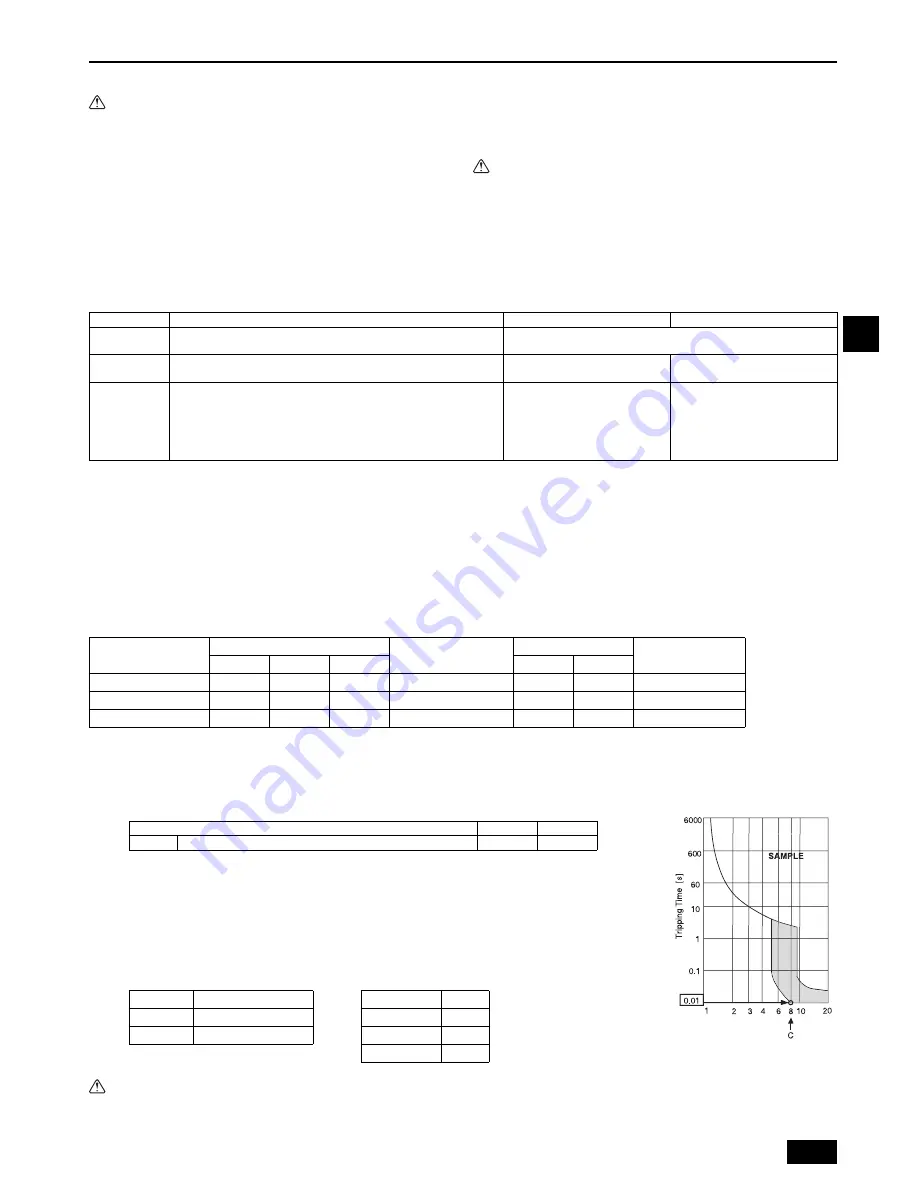
11
GB
9. Electrical wiring
Precautions on electrical wiring
Warning:
Electrical work should be done by qualified electrical engineers in accordance
with “Engineering Standards For Electrical Installation” and supplied installa-
tion manuals. Special circuits should also be used. If the power circuit lacks
capacity or has an installation failure, it may cause a risk of electric shock or
fire.
1. Be sure to install an earth leakage breaker to the power.
2. Install the unit to prevent that any of the control circuit cables (remote controller,
transmission cables) is brought in direct contact with the power cable outside the
unit.
3. Ensure that there is no slack on all wire connections.
4. Some cables (power, remote controller, transmission cables) above the ceiling
may be bitten by mouses. Use as many metal pipes as possible to insert the
cables into them for protection.
5. Never connect the power cable to leads for the transmission cables. Otherwise
the cables would be broken.
6. Be sure to connect control cables to the indoor unit, remote controller, and the
outdoor unit.
7. Put the unit to the ground on the outdoor unit side.
8. Select control cables from the conditions given in page
11
.
Caution:
•
Be sure to put the unit to the ground on the outdoor unit side. Do not con-
nect the earth cable to any gas pipe, water pipe, lightening rod, or tele-
phone earth cable. Incomplete grounding may cause a risk of electric
shock.
•
If the supply cord is damaged, it must be replaced by the manufacturer, its
service agent or similarly qualified persons in order to avoid a hazard.
Transmission cable specifications
9.1. Power supply wiring
•
Power supply cords of appliances shall not be lighter than design 245 IEC 57, 227 IEC 57, 245 IEC 53 or 227 IEC 53.
•
A switch with at least 3 mm contact separation in each pole shall be provided by the Air conditioner installation.
[Fig. 9.1.1] (P.4)
Apply to IEC61000-3-3 about Max. Permissive System Impedance.
*1 The Ground-fault interrupter should support Inverter circuit.
The Ground-fault interrupter should combine using of local switch or wiring breaker.
*2 Please take the larger of F1 or F2 as the value for F0.
F1 = Total operating maximum current of the indoor units
×
1.2
F2 = {V1
×
(Quantity of Type1)/C} + {V1
×
(Quantity of Type2)/C} + {V1
×
(Quantity of Type3)/C} + {V1
×
(Quantity of Others)/C}
C : Multiple of tripping current at tripping time 0.01s
Please pick up “C” from the tripping characteristic of the breaker.
<Example of “F2” calculation>
*Condition PEFY-VMA
×
3, C = 8 (refer to right sample chart)
F2 = 38
×
3/8
= 14.25
→
16 A breaker (Tripping current = 8
×
16 A at 0.01s)
*3 Current sensitivity is calculated using the following formula.
G1 = (V2
×
Quantity of Type1) + (V3
×
Wire length [km])
Caution:
Do not use anything other than the correct capacity breaker and fuse. Using fuse, wire or copper wire with too large capacity may cause a risk of malfunction or
fire.
Transmission cables
ME Remote controller cables
MA Remote controller cables
Type of cable
Shielding wire (2-core)
CVVS, CPEVS or MVVS
Sheathed 2-core cable (unshielded) CVV
Cable diameter
More than 1.25 mm
2
0.3 ~ 1.25 mm
2
(0.75 ~ 1.25 mm
2
)
*1
0.3 ~ 1.25 mm
2
(0.75 ~ 1.25 mm
2
)
*1
Remarks
Max length: 200 m
Maximum length of transmission lines for centralized control and indoor/
outdoor transmission lines (Maximum length via indoor units): 500 m MAX
The maximum length of the wiring between power supply unit for
transmission lines (on the transmission lines for centralized control) and
each outdoor unit and system controller is 200 m.
When 10 m is exceeded, use
cables with the same specification
as transmission cables.
Max length: 200 m
*1 Connected with simple remote controller.
CVVS, MVVS: PVC insulated PVC jacketed shielded control cable
CPEVS: PE insulated PVC jacketed shielded communication cable
CVV: PVC insulated PVC sheathed control cable
A
Ground-fault interrupter
B
Local switch/Wiring breaker
C
Indoor unit
D
Pull box
Total operating current of
the Indoor unit
Minimum wire thickness (mm
2
)
Ground-fault interrupter
*1
Local switch (A)
Breaker for wiring (A)
(Non-fuse breaker)
Main cable
Branch
Ground
Capacity
Fuse
F0 = 16 A or less
*2
1.5
1.5
1.5
20 A current sensitivity
*3
16
16
20
F0 = 25 A or less
*2
2.5
2.5
2.5
30 A current sensitivity
*3
25
25
30
F0 = 32 A or less
*2
4.0
4.0
4.0
40 A current sensitivity
*3
32
32
40
Indoor unit
V1
V2
Type1
PEFY-VMA
38
1.6
G1
Current sensitivity
Wire thickness
V3
30 or less
30 mA 0.1 sec or less
1.5 mm
2
48
100 or less
100 mA 0.1 sec or less
2.5 mm
2
56
4.0 mm
2
66
Rated Tripping current (x)
Sample chart
02_WT06410_GB.fm Page 11 Friday, November 25, 2011 3:59 PM


































